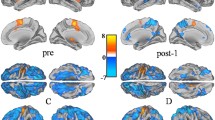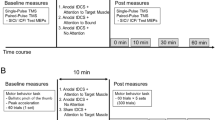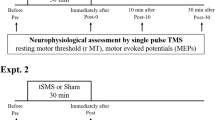Abstract
Repetitive transcranial magnetic stimulation combined with motor training (rTMS-MT) can be an effective method for enhancing motor function. However, the effects of rTMS-MT on inter-hemispheric lateralization remain unclear. Nineteen healthy volunteers were recruited. The volunteers were randomized to receive 2 weeks of rTMS-MT or MT to improve the motor function of the nondominant hand. Hand dexterity was tested by the Nine-Hole Peg Test. Resting motor threshold (RMT), motor evoked potentials (MEP) and electroencephalography (EEG) in the resting state with eyes closed were recorded, to calculate inter-hemispheric lateralization before and after rTMS-MT or MT. rTMS-MT and MT improved the dexterity and MEP amplitude of the nondominant hand. Furthermore, there were significant changes in the lateralization of not only power spectral density, but also information transmission efficiency between regions following rTMS-MT, especially between the central cortices of both hemispheres. However, although the lateralization change of the power spectral density between the central cortices was observed following MT, there was no such change for information transmission efficiency between any cortices. These results suggested that rTMS-MT could modulate inter-hemispheric lateralization. Changes in inter-hemispheric lateralization might be an important neural mechanism by which rTMS-MT improves motor function. These results could be helpful for understanding the brain mechanism of rTMS-MT.







Similar content being viewed by others
References
Albert NB, Robertson EM, Miall RC (2009) The resting human brain and motor learning. Curr Biol 19(12):1023–1027
Avenanti A, Coccia M, Ladavas E, Provinciali L, Ceravolo MG (2012) Low-frequency rTMS promotes use-dependent motor plasticity inchronic stroke: a randomized trial. Neurology 78:256–264
Babiloni C, Marzano N, Iacoboni M, Infarinato F, Aschieri P, Buffo P, Cibelli G, Soricelli A, Eusebi F, Del Percio C (2010) Resting state cortical rhythms in athletes: a high-resolution EEG study. Brain Res Bull 81(1):149–156
Bhatt E, Nagpal A, Greer KH, Grunewald TK, Steele JL, Wiemiller JW, Lewis SM, Carey JR (2007) Effect of finger tracking combined with electrical stimulation on brain reorganization and hand function in subjects with stroke. Exp Brain Res 182(4):435–447
Bolognini N, Pascualleone A, Fregni F (2009) Using non-invasive brain stimulation to augment motor training-induced plasticity. J Neuroeng Rehabil 6(1):8
Brasil-Neto JP, Cohen LG, Panizza M, Nilsson J, Roth BJ, Hallett M (1992) Optimal focal transcranial magnetic activation of the human motor cortex: effects of coil orientation, shape of the induced current pulse, and stimulus intensity. J Clin Neurophysiol 9(1):132–136
Carey JR, Fregni F, Pascual A (2006) rTMS combined with motor learning training in healthy subjects. Restor Neurol Neurosci 24(3):191–199
Chang WH, Kim YH, Yoo WK, Goo KH, Park CH, Kim ST, Pascual-Leone A (2012) rTMS with motor training modulates cortico-basal ganglia-thalamocortical circuits in stroke patients. Restor Neurol Neurosci 30(3):179–189
Conforto AB, Anjos SM, Saposnik G, Mello EA, Nagaya EM, Santos W Jr, Ferreiro KN, Melo ES, Reis FI, Scaff M, Cohen LG (2012) Transcranial magnetic stimulation in mild to severe hemiparesis early after stroke: a proof of principle and novel approach to improve motor function. J Neurol 259(7):1399–1405
Cramer SC, Nelles G, Benson RR, Kaplan JD, Parker RA, Kwong KK, Kennedy DN, Finklestein SP, Rosen BR (1997) A functional MRI study of subjects recovered from hemiparetic stroke. Stroke 28(12):2518–2527
Daselaar SM, Huijbers W, de Jonge M, Goltstein PM, Pennartz CM (2010) Experience-dependent alterations in conscious resting state activity following perceptuomotor learning. Neurobiol Learn Mem 93:422–427
Delorme A, Makeig S (2004) EEGLAB: an open source toolbox for analysis of single-trial EEG dynamics including independent component analysis. J Neurosci Methods 134(1):9–21
Delorme A, Sejnowski T, Makeig S (2007) Enhanced detection of artifacts in EEG data using higher-order statistics and independent component analysis. NeuroImage 34(4):1443–1449
Di Lazzaro V, Pilato F, Dileone M, Profice P, Capone F, Ranieri F, Musumeci G, Cianfoni A, Pasqualetti P, Tonali PA (2008) Modulating cortical excitfunction in acute stroke: a repetitive TMS study. Clin Neurophysiol 119(3):715–723
Dubovik S, Pignat JM, Ptak R, Aboulafia T, Allet L, Gillabert N, Magnin C, Albert F, Momjian-Mayor I, Nahum L, Lascano AM, Michel CM, Schnider A, Guggisberg AG (2012) The behavioral significance of coherent resting-state oscillations after stroke. Neuroimage 61(1):249
Emara TH, Moustafa RR, Elnahas NM, Elganzoury AM, Abdo TA, Mohamed SA, Eletribi MA (2010) Repetitive transcranial magnetic stimulation at 1 Hz and 5 Hz produces sustained improvement in motor function and disfunction after ischaemic stroke. Eur J Neurol 17(9):1203–1209
Farthing JP, Zehr EP (2014) Restoring symmetry: clinical applications of cross-education. Exerc Sport Sci Rev 42(2):70–75
Farthing JP, Krentz JR, Magnus CR, Barss T, Lanovaz JL, Cummine J, Esopenko C, Sarty GE, Borowsky R (2011) Changes in functional magnetic resonance imaging cortical activation with cross education to an immobilized limb. Med Sci Sport Exer 43(8):1394–1405
Fregni F, Boggio PS, Valle AC, Rocha RR, Duarte J, Ferreira MJ, Wagner T, Fecteau S, Rigonatti SP, Riberto M, Freedman SD, Pascual-Leone A (2006) A sham-controlled trial of a 5-day course of repetitive transcranial magnetic stimulation of the unaffected hemisphere in stroke patients. Stroke 37(8):2115–2122
Hilgetag CC, Théoret H, Pascual-Leone A (2001) Enhanced visual spatial attention ipsilateral to rTMS-induced ‘visual lesion’ of human parietal cortex. Nat Neurosci 4(9):953–957
Hummel F, Cohen LG (2005) Improvement of motor function with noninvasive cortical stimulation in a patient with chronic stroke. Neurorehabil Neural Repair 19(1):14–19
Hoffman RE, Cavus I (2002) Slow transcranial magnetic stimulation, long-term depotentiation, and brain hyperexcitfunction disorders. Am J Psychiatry 159(7):1093–1102
Jin JN, Wang X, Li Y, Jin F, Liu ZP, Yin T (2017) The effects of rTMS combined with motor training on functional connectivity in alpha frequency band. Front Behav Neurosci 11:234
Kakuda W, Abo M, Shimizu M, Sasanuma J, Okamoto T, Yokoi A, Taguchi K, Mitani S, Harashima H, Urushidani N, Urashima M (2012) A multi-center study on low-frequency rTMS combined with intensive occupational therapy for upper limb hemiparesis in post-stroke patients. J Neuroeng Rehabil 9(1):4
Kakuda W, Abo M, Sasanuma J, Shimizu M, Okamoto T, Kimura C, Kakita K, Hara H (2016) Combination protocol of low-frequency rTMS and intensive occupational therapy for post-stroke upper limb hemiparesis: a 6-year experience of more than 1700 Japanese patients. Transl Stroke Res 7(3):172–179
Kinsbourne M (1993) Integrated cortical field model of consciousness. Ciba Found Symp 174(1):43–50 (discussion 51–60)
Klimesch W (1997) EEG-alpha rhythms and memory processes. Int J Psychophysiol 26(1–3):319–340
Klimesch W (1999) EEG alpha and theta oscillations reflect cognitive and memory performance: a review and analysis. Brain Res Rev 29(2–3):169–195
Klimesch W, Sauseng P, Gerloff C (2003) Enhancing cognitive performance with repetitive transcranial magnetic stimulation at human individual alpha frequency. Eur J Neurosci 17(5):1129–1133
Kobayashi M, Hutchinson S, Théoret H, Schlaug G, Pascual-Leone A (2004) Repetitive TMS of the motor cortex improves ipsilateral sequential simple finger movements. Neurology 62(1):91–98
Kondo T, Kakuda W, Yamada N, Shimizu M, Abo M (2015) Effects of repetitive transcranial magnetic stimulation and intensive occupational therapy on motor neuron excitfunction in poststroke hemiparetic patients: a neurophysiological investigation using F-wave parameters. Int J Neurosci 125(1):25–31
Kwon TG, Kim YH, Chang WH, Bang OY, Shin YI (2014) Effective method of combining rTMS and motor training in stroke patients. Restor Neurol Neurosci 32(2):223–232
Latora V, Marchiori M (2001) Efficient behavior of small-world networks. Phys Rev Lett 87(19):198701
Lee JH, Byun JH, Choe YR, Lim SK, Lee KY, Choi IS (2015) Successful treatment of phantom limb pain by 1 Hz repetitive transcranial magnetic stimulation over affected supplementary motor complex: a case report. Ann Rehabil Med 39(4):630–633
Lewis CM, Baldassarre A, Committeri G, Romani GL, Corbetta M (2009) Learning sculpts the spontaneous activity of the resting human brain. Proc Natl Acad Sci USA 106(41):17558–17563
Lim VK, Hamm JP, Byblow WD, Kirk IJ (2006) Decreased desychronisation during self-paced movements in frequency bands involving sensorimotor integration and motor functioning in Parkinson’s disease. Brain Res Bull 71(1–3):245–251
Lüdemann-Podubecká J, Bösl K, Theilig S, Wiederer R, Nowak DA (2015) The effectiveness of 1 Hz rTMS over the primary motor area of the unaffected hemisphere to improve hand function after stroke depends on hemispheric dominance. Brain Stimul 8(4):823–830
Mathiowetz V, Weber K, Kashman N, Volland G (1985) Adult norms for the nine hole peg test of finger dexterity. Occup Ther J Res 5(1):24–38
Mills KR, Boniface SJ, Schubert M (1992) Magnetic brain stimulation with a double coil: the importance of coil orientation. Electroencephalogr Clin Neurophysiol 85(1):17–21
Mozaffarian D, Benjamin EJ, Go AS, Arnett DK, Blaha MJ, Cushman M, de Ferranti S, Després JP, Fullerton HJ, Howard VJ, Huffman MD, Judd SE, Kissela BM, Lackland DT, Lichtman JH, Lisabeth LD, Liu S, Mackey RH, Matchar DB, McGuire DK, Mohler ER, Moy CS, Muntner P, Mussolino ME, Nasir K, Neumar RW, Nichol G, Palaniappan L, Pandey DK, Reeves MJ, Rodriguez CJ, Sorlie PD, Stein J, Towfighi A, Turan TN, Virani SS, Willey JZ, Woo D, Yeh RW, Turner MB (2015) art disease and stroke statistics–2015 update: a report from the American heart association. Circulation 131(4):e29–e322
Neubauer A, Freudenthaler HH, Pfurtscheller G (1995) Intelligence and spatiotemporal patterns of event-related desynchronization (ERD). Intelligence 20(3):249–266
Nowak DA, Grefkes C, Ameli MD, Gereon RF (2009) Interhemispheric competition after stroke: brain stimulation to enhance recovery of function of the affected hand [J]. Neurorehabil Neural Repair 23(7):641–656
Nyffeler T, Müri R (2010) Comment on: Safety, ethical considerations, and application guidelines for the use of transcranial magnetic stimulation in clinical practice and research. Clin Neurophysiol 121(6):980
Pal PK, Hanajima R, Gunraj CA, Li JY, Wagle-Shukla A, Morgante F, Chen R (2005) Effect of low-frequency repetitive transcranial magnetic stimulation on interhemispheric inhibition. J Neurophysiol 94(3):1668–1675
Park E, Kim YH, Chang WH, Kwon TG, Shin YI (2014) Interhemispheric modulation of dual-mode, noninvasive brain stimulation on motor function. Ann Rehabil Med 38(3):297–303
Pearce AJ, Hendy A, Bowen WA, Kidgell DJ (2013) Corticospinal adaptations and strength maintenance in the immobilized arm following 3 weeks unilateral strength training. Scand J Med Sci Sports 23(6):740–748
Podubecka J, Bösl K, Nowak D (2010) 1 Hz rTMS over M1 of the unaffected hemisphere enhances the effectiveness of a 3-week motor training to improve function of the affected hand after stroke. Klin Neurophysiol 41:1
Sandrini M, Cohen LG (2013) Noninvasive brain stimulation in neurorehabilitation. Handb Clin Neurol 116:499–524
Sporns O (2013) Structure and function of complex brain networks. Dialogues Clin Neurosci 15(3):247–262
Stam CJ, Nolte G, Daffertshofer A (2007) Phase lag index: assessment of functional connectivity from multichannel EEG and MEG with diminished bias from common sources. Hum Brain Mapp 28:1178–1193
Takekawa T, Kakuda W, Uchiyama M, Ikegaya M, Abo M (2014) Brain perfusion and upper limb motor function: a pilot study on the correlation between evolution of asymmetry in cerebral blood flow and improvement in Fugl-Meyer Assessment score after rTMS in chronic post-stroke patients. J Neuroradiol 41(3):177–183
Thuraisingham AR (2015) A different perspective of multi-channel EEG data using network analysis. Biomed Phys Eng Express 1:025001
Ward NS (2005) Plasticity and the functional reorganization of the human brain. Int J Psychophysiol 58(2):158–161
Woźniak-Kwaśniewska A, Szekely D, Aussedat P, Bougerol T, David O (2014) Changes of oscillatory brain activity induced by repetitive transcranial magnetic stimulation of the left dorsolateral prefrontal cortex in healthy subjects. NeuroImage 88:91–99
Acknowledgements
This study was supported by the CAMS Initiative for Innovative Medicine NO2016-I2M-1004, Special Funds of the National Natural Science Foundation of China NO81127003 and Special Funds of the Key Technologies R&D program of Tianjin, China NO17YFZCSY00730.
Author information
Authors and Affiliations
Corresponding authors
Additional information
Publisher's Note
Springer Nature remains neutral with regard to jurisdictional claims in published maps and institutional affiliations.
Electronic supplementary material
Below is the link to the electronic supplementary material.
Rights and permissions
About this article
Cite this article
Jin, Jn., Wang, X., Li, Y. et al. rTMS combined with motor training changed the inter-hemispheric lateralization. Exp Brain Res 237, 2735–2746 (2019). https://doi.org/10.1007/s00221-019-05621-z
Received:
Accepted:
Published:
Issue Date:
DOI: https://doi.org/10.1007/s00221-019-05621-z




